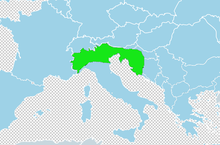Salmo marmoratus
| Salmo marmoratus | |
|---|---|

| |
| Scientific classification | |
| Domain: | Eukaryota |
| Kingdom: | Animalia |
| Phylum: | Chordata |
| Class: | Actinopterygii |
| Order: | Salmoniformes |
| Family: | Salmonidae |
| Genus: | Salmo |
| Species: | S. marmoratus
|
| Binomial name | |
| Salmo marmoratus G. Cuvier,1829
| |

| |
Salmo marmoratus,themarble trout,is a species offreshwater fishin the familySalmonidae.It is characterized by a distinctive marbled color pattern and high growth capacity. The marble trout is found in only a handful of drainages and rivers of theAdriaticbasin in (going from north to south)Italy,Slovenia,Croatia,Bosnia and Herzegovina,andMontenegro,while inAlbania,the species is considered most likelyextirpated.
Distribution
[edit]In Italy, marble trout inhabits left tributaries of the upper northwestern reaches of thePo River,and Italian northeastern sub-Alpine region's direct Adriatic watersheds, namely theAdige,theBrenta,thePiave,theTagliamento,and theLivenza;in shared Slovenia and Italy drainage of theSočawithNatisone;in shared Bosnia and Herzegovina and Croatia drainage of theNeretvariver, and in shared Montenegro and Albania drainage of theMoračawithZetariver, and the tributaryCem(Cijevna).[2]While once present in theDrinriver basin in Albania, withWhite DrininKosovoandBlack DrininNorth Macedoniaand Albania (as well as the Zalli i Bulqizes and the Okshtuni tributaries), and theAoosriver basin in Albania andGreece(as well as theSarantaporosand theDrinotributaries), the fish is almost certainlyextirpatedthere.[3][4][5]
Appearance, biology, and ecology
[edit]
The marble trout has a long, cylindrical body, slightly compressed laterally, with a large head (22–25% of the body length), which is why it is also known asglavatica(glava= head) inBosnian.The most obvious characteristic of the marble trout is its marble pattern. The intensity of colour varies considerably upon the surroundings. Some marble trout have red spots that merge with the rest of the pigment, always only along the lateral line.[6]
Its typical size is 30–70 cm. The largest specimen in Slovenia was a 117-cm, 24-kg female (found dead),[7]largest living specimen caught was 120 cm and 22.5 kg.[8]Individuals weighing up to 30 kg have been reported.[6]The largest specimens were found in Bosnia and Herzegovina, inhabiting theNeretvaRiver from below town ofKonjicdownstream to town ofČapljina,mostly in canyon section from town ofJablanicato city ofMostar,and later after construction of Jablanica Dam on theNeretvaRiver inJablaničko Lake.[9]Troutbecome sexually mature at the age 3+ years (males) and 4+ years (females), and they spawn during November and December.
The marble trout ispiscivorous,feed mainly on smaller fish andbenthicinvertebrates.

Its naturalhabitatisriverswith a summer temperature of 15 °C (59 °F). It suffers numerous threats to its existence throughout its range, these includehybridisationwith foreign trout species stocked for angling, water extraction, and pollution. In Bosnia and Herzegovina, its main threats arehabitat loss(habitat destruction) due to construction of five large dams on the Neretva Rriver and plans for construction of several new dams on the upper course of the Neretva, water pollution, overfishing (sportfishing, food, includingpoaching), and hybridisation withintroduced speciesof trout.
All eight remaining genetically pure marble trout populations were found in remote streams of the RiverSočabasin.[10]From these populations theTolminAngler's Society launched a reintroduction programme.[11]
Marmorated trout
[edit]Adding to the confusion of salmonid taxonomy, other trout have marble patterns besideS. marmoratus.One is trout from the riverOtra,Norway.A certain percentage ofbrown trout(Salmo trutta) from that river have a marble pattern. In all other aspects, these trout are identical to the nonmarble brown trout from the same river. This is an example of intrapopulationalpolymorphism.[12][13]
References
[edit]- ^Crivelli, A.J. (2006)."Salmo marmoratus".IUCN Red List of Threatened Species.2006:e.T19859A9043279.doi:10.2305/IUCN.UK.2006.RLTS.T19859A9043279.en.Retrieved14 November2021.
- ^"Fish Database - Save the Blue Heart of Europe".balkanrivers.net.Retrieved1 July2019.
- ^"Marble trout (Salmo marmoratus)".Balkan Trout Restoration Group.Retrieved2009-03-10.
- ^S. MUHAMEDAGIĆ; H. M. GJOEN; M. VEGRA (2008)."Salmonids of the Neretva river basin - p"(PDF).EIFAC FAO Fisheries and Aqauculture Report No. 871.European Inland Fisheries Advisory Commission (EIFAC): 224–233.Retrieved6 January2014.
- ^Snoj, Aleš; Marić, Saša; Berrebi, Patrick; Crivelli, Alain J.; Shumka, Spase; Sušnik, Simona (2 February 2009)."Genetic architecture of trout from Albania as revealed by mtDNA control region variation".Genetics Selection Evolution.41(1): 22.doi:10.1186/1297-9686-41-22.ISSN1297-9686.PMC3225828.PMID19284692.
- ^abPovž M; Jesenšek D; Berrebi P; Crivelli AJ (1996).The Marble Trout Salmo trutta marmoratus, Cuvier 1817 In the Soca River basin, Slovenia(PDF).
- ^Pintar L (1991). "Najtežja soška postrv je končala pod peskom".Ribič.50(1–2): 16.
- ^"Soca (19) – Ribiška družina Tolmin".
- ^Mateš, Antun (2004).The Enchanted Angler.Zagreb: J&B d.o.o.ISBN953-99019-3-6.
- ^Fumagalli L; Snoj A; Jesenšek D; Balloux F; Jug T; Duron O; Brossier F; Crivelli AJ; Berrebi P (2002)."Extreme genetic differentiation among the remnant populations of marble trout (Salmo marmoratus) in Slovenia "(PDF).Mol. Ecol.11(12): 2711–2716.Bibcode:2002MolEc..11.2711F.doi:10.1046/j.1365-294X.2002.01648.x.PMID12453253.S2CID23810662.
- ^Fish farming
- ^Skaala O; Solberg G (1997). "Biochemical genetic variability and the taxonomic position of the marmorated trout in River Otra, Norway".Nord. J. Freshw. Res.
- ^Crivelli, A.J. (2006)."Salmo marmoratus".IUCN Red List of Threatened Species.2006.Retrieved2020-05-28.

